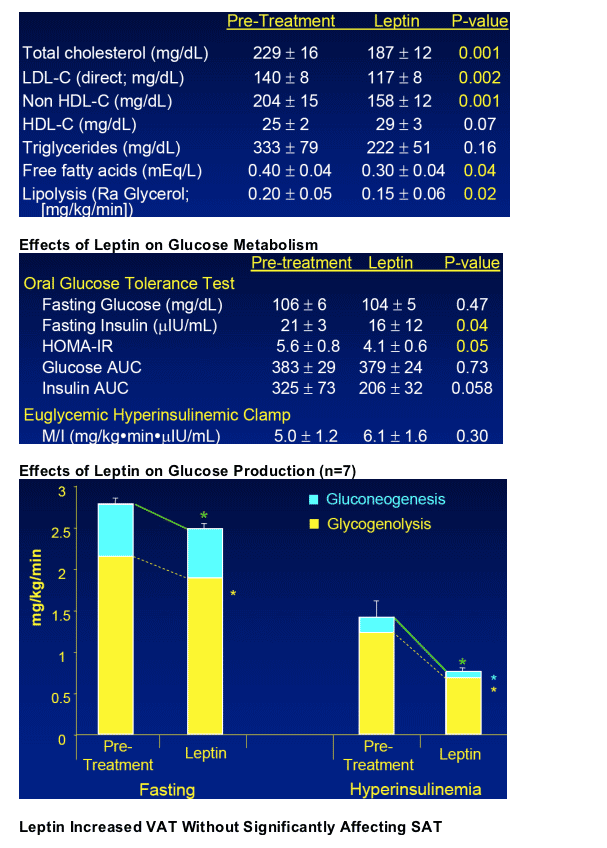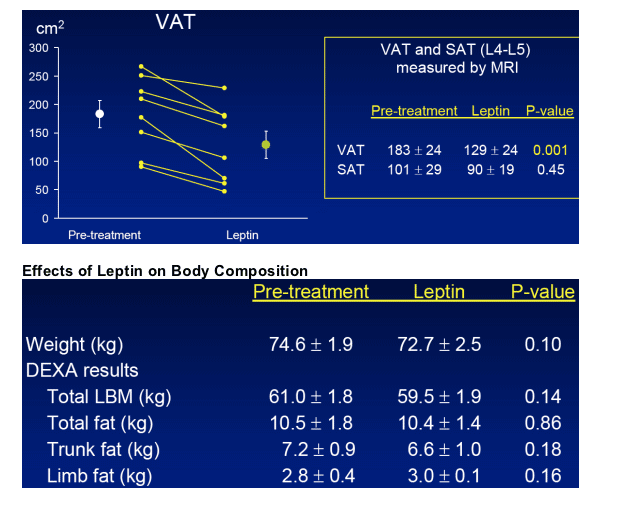 |
 |
 |
| |
Leptin Improves Visceral Belly Fat, Dyslipidemia, and Insulin Resistance
|
| |
| |
"Effects of Leptin Treatment on Glucose and Lipid Metabolism and Fat Distribution in HIV+ Patients with Lipoatrophy and Hypoleptinemia"
Reported by Jules Levin
8th Intl Workshop on Adverse Drug Reactions & Lipodystrophy in HIV
San Francisco, Sept 26, 2006
Hootan Khatami (University of California, SF) reported the study results at the Lipodystrophy Workshop; K Mulligan, JM Schwartz, GK Sakkas, AM DePaoli, S Park, S Kim, VW Tai, M Wen, GA Lee, C Grunfeld, M Schamnelan; Touro University, Vallejo, CA; Amgen Inc, Thousand Oaks, CA.
This is an open-label, proof of principle study to determine whether leptin can produce metabolic benefits in HIV+ patients with lipoatrophy. 8 HIV+ men with lipoatrophy (+/- fat accumulation), fasting triglycerides >300 mg/dl (or if on anti-lipid therapy, documented previously), hypoleptinemia (<3 ng/ml), dyslipidemia, and insulin resistance received recombinant human leptin (Amgen, Inc) for 6 months (0.01 mg/kg BID for 3 months, followed by 0.03 mg/kg BID for 3 additional months. Glucose and lipid metabolism was assessed under fasting conditions and during a euglycaemic, hyperinsulinemic clamp with stable isotope infusions measuring endogonous glucose production, gluconeogenesis, glycogenolysis, and lipolysis at baseline and month 6. Body composition was assessed by DEXA and MRI. Data are mean +/- SE: VAT & SAT by MRI; total & regional fat and LBM by DEXA. Study measurements performed during 5-day GCRC admissions with subjects consuming fixed weight-maintaining diets).
SUMMARY & CONCLUSIONS by Authors
In this small open-label proof-of principle study:
- - Leptin treatment was well tolerated; no clinical or laboratory adverse events were observed.
- - Leptin improved dyslipidemia: total, LDL, and non-HDL cholesterol decreased, while HDL tended to increase.
- - Leptin treatment was associated with improvements in insulin sensitivity in the liver but the increase in whole-body glucose uptake did not achieve significance.
- - Leptin decreased lipolysis, also suggesting an effect on adiposetissue.
- - Visceral fat decreased in all subjects.
- - There was no exacerbation of peripheral lipoatrophy.
- - These latter results suggest that leptin may have a depot-specific effect in adipose tissue.
Hepatic insulin sensivity improved, as evidenced by significant decreases in fasting insulin (21±3 to 16±2 uIU/ml at baseline and month 6, respectively, p=0.04, 0.05), HOMA-IR (5.6±0.8 to 4.1±0.6, p=0.036), endogenous glucose production (2.78±0.07 to 2.47±0.07) mg/kg/min, p=0.005), glycogenesis (2.15±0.07 to 1.89±0.06 mg/kg/min, p=0.029). Leptin treatment also improved the ability of insulin to suppress endogenous glucose production (49±7 to 69±2% suppression, p=0.018), glycogenolysis (43±8 to 64±4%, p=0.023), gluconeogenesis (72±6 to 87±3%, p=0.019) during the euglycaemic hyperinsulinemic clamp.
Incontrast, although peripheral glucose uptake (clamp) improved in some subjects, overall there was no statistically significant change. Whole-body lipolysis decreased significantly under fasting conditions (0.20 ±0.02 to 0.15 ±0.02 mg/kg/min, p=0.022).
EFFECTS OF LEPTIN ON LIPID METABOLISM (fasting values)
Mean before therapy & after 6 months of therapy.
7 of 8 subjects were on lipid lowering therapy throughout the study.


BACKGROUND
Fatless mice (A-ZIP/F-1, nSREBP-1c) exhibit:
-severe insulin resistance
-hypertriglyceridemia
-hepatic steatosis
-decreased adipocyte-derived proteins involved in glucose and lipid metabolism (e.g. leptin, adiponectin)
Transplantation of fat from wild-type mice of the same strain ameliorates these metabolic abnormalities.
HIV-infected and uninfected humans with lipoatrophy manifest a similar metabolic profile, including hypoleptinemia, hypertriglyceridemia and hyperinsulinemia.
Treatment with leptin ameliorates these metabolic abnormalities in mice as well as patients with lipoatrophy.
Shimomura Genes Dev 1998; MoitraGenes Dev 1998; GavrilovaJCI 2000; ReitmanTrends EndocrinolMetab2000; Carr AIDS 1998; Nagy CID 2003; Oral NEJM 2002; Shimomura Nature 1999; Lee JCEM 2006


|
| |
|
 |
 |
|
|